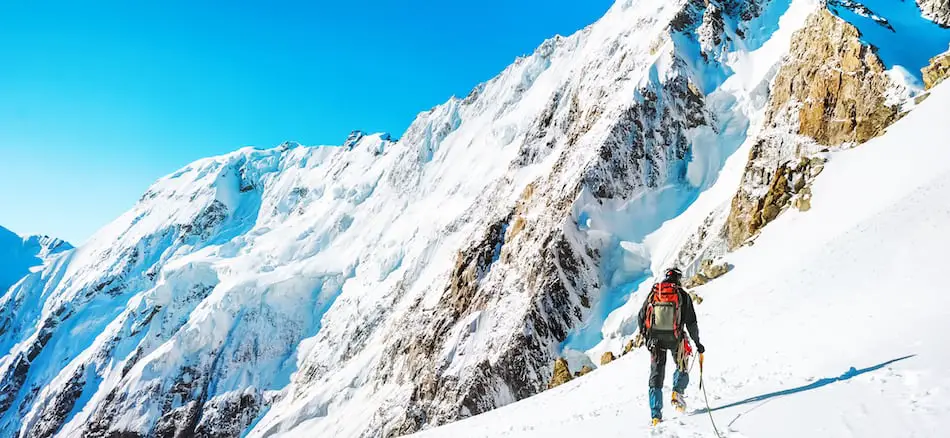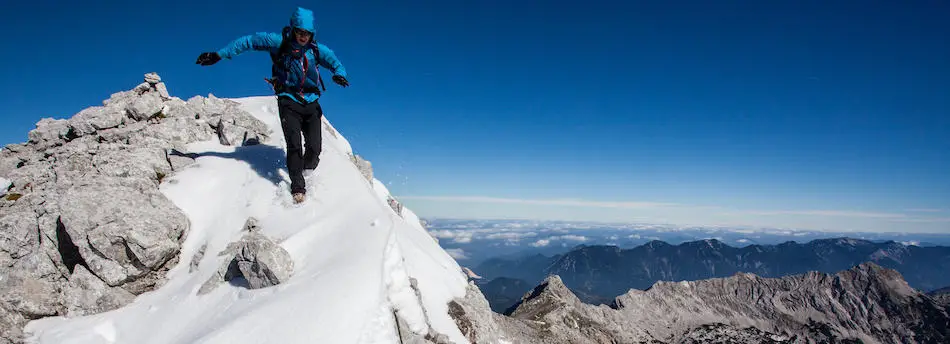
When I was first getting into mountain climbing, I was confused about the difference between mountaineering and alpinism. I’ve put the following guide together to help explain it a little more!
So, what’s the difference between mountaineering and alpinism? Mountaineers will ascend and descend a mountain several times to acclimatize, whereas alpinists traditionally climb the mountain in one continuous ‘push’.
If you ask some people, they may tell you that mountaineering and alpinism are the same thing. In fact, lots of people use the two interchangeably, and for good reason; both describe the act of climbing technically difficult mountains using a variety of skills like ice climbing, rock climbing, and glacier travel. However, there are subtle differences in the approach taken to get to the summit. Mountaineering is usually used to describe traditional ‘siege’ tactics, where you go up and down the mountain multiple times before making a push for the summit. Alpinism, on the other hand, focuses on ‘fast and light’ ascents.
Mountaineering vs. Alpinism

First, let’s break down the difference between the two activities in general terms, before I go into more detail about the pros and cons of each approach.
Put simply, mountaineering and alpinism are different approaches to the same goal. Both activities focus on reaching a summit, but the approaches that they take are different.
A mountaineering expedition is a slow, methodical, well-provisioned attack against a peak; it’s often described as a ‘siege’. This is the tactic that most people will take for extremely difficult mountains like Everest or Cho Oyu.
In this case, mountaineers will set up a ‘base camp’ where they keep the majority of their supplies. They will then go up a little bit on the mountain (say, 1,000 meters) before retreating back to base camp. A couple of days later they’ll go up higher (2,000 meters), and then retreat again, slowly working their way up until they reach the summit.
Doing it this way gives them certain advantages like acclimatizing to altitude and setting fixed ropes. However, it can also expose them to more dangers.
Alpinists, however, climb a mountain in a single push, carrying all of their gear with them. It’s more of an ‘all or nothing approach’. They set fewer camps, carry fewer supplies, and will often only spend 3-5 days on the mountain (as opposed to a full-out mountaineering siege, which can last months). This lowers their exposure to certain risks, but it’s also much more physically demanding.
Now, I should say this: in most cases, you can use the terms interchangeably. If you say you’re going mountaineering in the Rockies, most people won’t assume that you’re going to pitch a tent and stay there for months on end.
When it comes to big mountains, though, the words are often distinct in their meaning. If someone tells you that they climbed Mt. Everest, they probably took a siege approach (mountaineering approach) to it. If, though, they said that they climbed Mt. Everest ‘alpine style’, that likely means that they were opting for less gear and no fixed camps.
So, why the difference between the two approaches? What are some of the pros and cons?
Alpinism Approach

If you want to go back (like way, way back), alpinism in its purest form is the original mountain-climbing technique. This harkens all the way back to 1786, when two Frenchmen named Jacques Balmat and Dr. Michel Paccard scaled Mont Blanc.
This is widely considered to be the ascent in mountain climbing, and it gave birth to a whole new sport. The climb was done in a single push to the summit, with no intermediate camps set up along the way.
Back then, Balmat and Paccard climbed the mountain alpine style because they didn’t know better. Nowadays, though, there are three main reasons that you might try to climb a mountain in this form:
- Practicality: Some mountains are just too small for it to be worth engaging in an all-out mountaineering endeavour. If it can be climbed in a day or two, alpinism makes more sense.
- Safety: In certain instances, alpinism can be the safer approach (more on this later)
- Pride: Some people consider alpinism to be a more ‘pure’ form of mountain climbing
Pros
So, with that being said, what are some of the upsides of taking an alpine approach to mountain climbing?
Less Risk of Exposure
Alpinists are often described as moving ‘fast and light’. This means that you’re on and off the mountain in a matter of days, rather than mountaineers who will hang around for months on end.
The less time you spend on a mountain, the less time you’re exposed to certain risks like avalanches or icefall. If you only pass through a dangerous section once, you have lower odds of getting hit by an avalanche than if you were to pass through it dozens of times as a mountaineer may.
This is why for some of the most dangerous mountains in the world, like K2, people will acclimatize on a different peak and then attempt the dangerous mountain in alpine style.
Used on a Wide Variety of Mountains
As I said above, alpinism is more applicable to the peaks that most of us will actually be climbing. Few people ever take a shot at Everest; most of the mountains you climb in your life are smaller objectives that can be scaled in a day.
For this type of mountain, alpinism makes more sense.
Cheaper and Takes Less Time
Mountain climbing expeditions are expensive, and not everyone has a job that allows them to disappear for months on end. In this way, alpine ascents allow you to get up and down in a matter of days, shortening the time you need to take off work and the equipment you need.
Seen as more ‘pure’
This one is a bit less important, but some people do see it as a purer form of mountain climbing to attempt it in an alpine style, without the advantage of fixed camps and repeated ascents.
If that’s something that matters to you, alpinism is the way to go.
Cons
However, there are also some downsides to taking this approach!
Harder
To put it simply, alpine ascents are harder than mountaineering ascents are. You have to carry more gear, you’re not familiar with the terrain, and you don’t have the advantaged of fixed ropes.
All of these factors add up to mean that alpinism requires a much higher degree of skill and fitness than mountaineering does. You have less chance of reaching the summit and more chance of something bad happening to you.
Mountaineering Approach

If alpinism is the ‘traditional’ approach, harkening back to the 1700’s, mountaineering may be the more famous one. Some of history’s most earth-shattering ascents, like the first summit of Mt. Everest, were performed mountaineering style.
When mountaineering, the goal is to launch a ‘siege’ on the mountain. You set up a base camp and then venture up the peak in small increments, leaving behind gear, camps, and fixed lines. You then go back down, rest, and try again.
Doing this allows you to plan your route methodically, do more preparation, and get used to the terrain before you make your final push for the summit. Some mountaineering expeditions will even use porters to haul gear and set up camps.
Pros
So, what are some of the advantages of this style?
Acclimatization
A big one, especially in larger mountain ranges, is acclimatization — allowing your body to adjust to the lower levels of oxygen that you find on tall summits. Going up and down the peak as mountaineers do allows you to adapt, so that you’ll find it easier to breath on your finals summit push.
Less Weight
Because you have the ability to fix camps and use porters, you’ll have to take less gear with you when you’re actually climbing. This means that you can move faster, pass through more technical terrain, and have a higher chance of summitting.
Ability to Fix Protection
Mountaineers will often leave fixed ropes behind them when they retreat from a mountain; this makes it easier and safer to ascend the next time they go up.
Doing this makes the uphill easier and lowers the chance of someone taking a dangerous fall, all of which makes it more likely that you summit the mountain.
Familiarity with Your Terrain
Finally, the more times you go up and down the mountain, the more familiar you become with it, and the fast you can move. Like everything else on this list, that helps you stay safer and increases your odds of summitting.
Essentially, the pros of mountaineering can be boiled down to: it (almost always) makes it more likely that you’ll reach the summit.
Cons
However, while this approach certainly has its advantages, there are a couple of downsides that you should also be aware of:
Higher Risk of Exposure
As I said in the alpinism section, mountaineering comes with a higher risk of exposure. This is because you have to go up and down the mountain several times; any dangerous sections on the route will be passed through over and over again, increasing the odds of an accident happening.
Greater Cost
Finally, mountaineering expeditions are long and expensive. You need lots of food, lots of time off of work, and lots of gear to pitch multiple camps, hire porters, and move your team up and down the mountain repeatedly.
